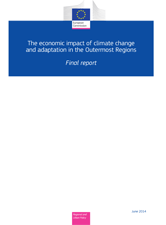
As the climate of the globe changes, the resilience of regions to the impacts of climate change will not be uniform. Some regions will experience more severe changes than others, changes which threaten areas of high biodiversity importance (‘biodiversity hotspots’) or locally important economic activities and livelihoods. Others, while not being exposed to such severe impacts may have limited adaptive capacity and so be vulnerable to climate impacts. The European Union (EU) Adaptation Strategy, adopted in spring 2013, recognises that the Outermost Regions (OR) of the EU are particularly vulnerable to the impacts of climate change. They are regions characterised by their remoteness, insularity, climate, terrain and richness of biodiversity as well as an economic dependence on a small number of products. They are important to the EU for the development of trade with third countries.
The OR are an integral part of the EU and are subject to the same regulations, policies and directives as the rest of the EU however, in a changing climate, the OR are also amongst the parts of EU facing some of the most significant challenges. Major impacts to their ecosystems have been identified including extinction of endemic species, coral bleaching and shoreline erosion. Observations have already shown changes to water and air temperature, cyclone activity, ocean acidification and sea level rise have occurred. Such observed changes are consistent with projections of future climate change.
